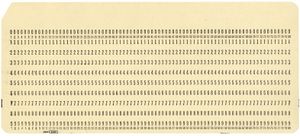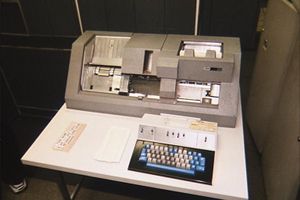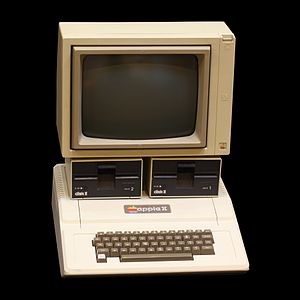First-Hand:My recollections as an educator
Submitted by Srini Srinivasan
My experience using computers started in 1975 when I was a doctoral student at the University of Pittsburgh in Pittsburgh, PA. It was an IBM computer. In those days 132-column computer printer paper was very common. It was light green in color and it had alternating dark and light green strips in which the prints appeared. The input to the computer was via a deck of cards. I was not aware of any portable computers that people could use outside the Computer Centers. In order to use the computer, I had to walk to the Computer Center and sit at the Keypunch machine to create the deck of cards with the program that I wanted. I used FORTRAN language at that time. I remember that at the University of Pittsburgh at that time the deck of cards was available freely and I did not pay for the cards as a student. It was an 80-column IBM card.
When you place the card on the hole punch machine and typed, you got a punched card with the content of what you typed appearing at the top of the card. If you made a mistake while typing, then you had to put a new card and you can use the recall button to come up to the column you typed right and then continue typing normally. The previously punched card is now a waste.
After you created your deck for processing by the computer, you placed a rubber band on the deck and gave the deck to the computer operator. The computer operators were mostly other students employed by the computer center. They would place the card deck in a card reader and then you wait your turn to get your output. Usually, the outputs came within 15 minutes. If the program ran correctly, you got a good output. Otherwise, the output showed the errors in the logic and you have to correct them and resubmit for processing. The computer operator handed you back the card deck immediately after it is read or when you picked up your printed output. In those days, others viewed you as a good programmer if you had a large printed output. Keep in mind that you can easily increase the loop upper bound to a large number to get a large output. This was my first use of computers. Around 1979, Cathode Ray Tube (CRT) terminals started appearing to replace the computer cards. Still these terminals were in the Computer Center and the job was running remotely at a far off location from campus. For this reason, these terminals were called Remote Job Entry (RJE) terminals. The advantage is that you were able to submit the job for executing yourself. The Computer Centers were open longer hours in order to accommodate the student and faculty needs. They were not open 24 hours then. My recollection is that they were open from 8 a.m. to midnight. While I was at the University of Pittsburgh I had heard of portable computers that could be used using a dial-up modem. I did not have access to one of that. I heard that the initial dial-up speed was 110 baud. That meant, it literally took several seconds for a character to be fully formed on your portable computer’s print out because everything then had to be a print out as there was no computer screen to see what you are communicating with the computer.
In 1982, I moved to the University of Akron in Ohio upon graduation the year before. When I joined the University of Akron Mathematics Department as an Assistant Professor, it was called the Department of Mathematical Sciences and it included courses in Statistics and Computer Science besides Mathematics. The department Chair at that time was not assigning instructors for courses until the first day of classes. This was fine with Mathematics professors. None of them wanted to teach Computer Science courses this way. So, in my first semester there, my teaching assignment consisted of 5 computer science courses, which is two courses more than the normal load. When I was hired I had told them that I could teach Computer Science classes because I had taken Computer Science classes at the University of Pittsburgh out of my own interest. Those courses did not appear in my transcript but that did not matter. I taught four days a week and some days the last class ended at 10 p.m. The Chairman of the Department changed one class time to avoid a time conflict so that I could teach that class. When I joined University of Akron, they were still using the IBM cards and there were no CRT terminals to use. Students had to buy the IBM cards and they were dispensed from vending machines like we see soft drink vending machines today. Each deck that the machines dispensed consisted of 100 cards and they were quite inexpensive. I remember that the CRT terminals came there in 1983. At that time the department had a computer lab that consisted of several Apple II terminals. The screen was small (around 12” square), the cursor was green and the characters were large. This meant that the screen could accommodate only a small amount of text a time and the rest had to be scrolled. The early word processor that I used at the University of Akron was called Bank Street Writer.
When I was a faculty member at the University of Akron Mathematical Sciences department, they had two portable computers. They could be taken home for accessing the computer system via a dial-up system. A dial-up system would tie up your phone line and if you had Call Waiting, that tone would disable your connection with any incoming call. In the very early days of dial-up, we did not have Call Waiting feature available and so dropping a computer connection was not a problem. Later on it became a huge problem. The portable computer literally weighed 50 lbs and was the size of a roll-out bag. It had a built-in modem that you used to connect to the university computer system. The paper used was a special role of thermal paper that turned to yellow color after a few days. It was very glossy. The role of paper came in 8.5” width and it was very long, probably 100 feet. The dial-up speed was initially 300 baud, which meant you could see the dot matrix print out that you got from the portable computer slowly make each character. The dial-up speed slowly increased until it reached 53.6 bits per second. That was considered pretty fast those days.
Later on, I joined Austin Peay State University in Clarksville, TN where it was the Department of Mathematics. There was no Computer Science Department at that time even though my appointment was to teach Computer Science courses only. At the Austin Peay State University, the computer system was by Digital Equipment Corporation (DEC). The system was called VAX. VAX stands for Virtual Address eXtension. It is a method of addressing the memory location. VAX is considered a mid-range computer, also known at that time as a mini-computer. IBM computers were called mainframe computers. I remember it as VAX 760 computer system. In those days the price of a mainframe computer was in millions of dollars whereas the mini-computers were in the $200,000 range. I had heard of DEC while at the University of Pittsburgh because several Physics Labs had acquired an even smaller computer called PDP-11. PDP stands for Programmed Data Processor. It was a very popular minicomputer at that time. DEC was headquartered in Maynard, MA. The company was created by Kenneth Olsen, formerly of MIT. I remember using a popular search engine called Altavista that DEC introduced. DEC company was sold to Compaq which was then sold to Hewlett Packard company. The DEC name disappeared from use. Altavista was sold to Yahoo search engine. Around 1986, CRT terminals started appearing on college campuses. Also, IBM PCs were introduced at that time for students use. IBM systems were in virtually all college campuses as the company believed that if students are introduced to their systems early then they would adopt it later when they are employed. That turned out to be a very valid point and IBM provided all PCs to the universities at no cost. The computer labs acquired a few Macintosh computers at that time but there was no Apple Lab of any kind because Apple company did not provide free computers for colleges like IBM did. I came to know later that around 2002, University of Akron started its Computer Science Department and Austin Peay State University started its Computer Science department around 2003. Computer Science programs evolved from Mathematics departments mostly but in some places they also evolved from Electrical Engineering or Physics departments. Today, most colleges and universities have separate Computer Science departments.


